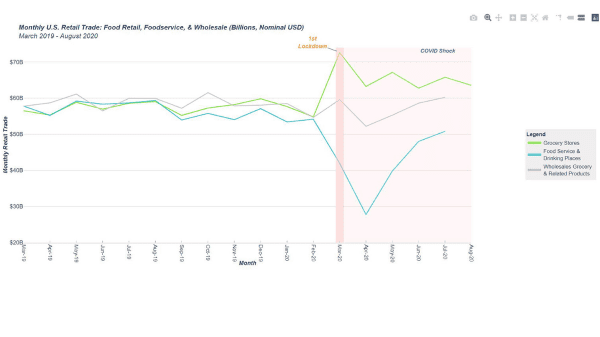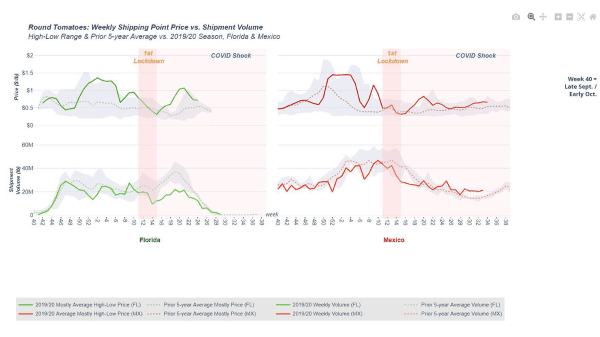
There are many factors pointing to the success tomatoes have had in the past year. But some varieties and growing regions have done better than others.
The Fresh Produce Association of the Americas’ BB #:144354 Tomato Week highlighted the category’s surge in popularity in 2020, noting that retail sales were 17.6 percent higher than 2019, outpacing overall produce sales at retail, which was 10.1 percent above the prior year.
A March 11 webinar used the data that the Department of Agricultural & Resource Economics at University of Arizona gathered showing how the pandemic affected the fresh tomato industry.
While retail and foodservice dramatically diverged last March, as lockdowns were implemented across the U.S., Dan Scheitrum from U of A, said Roma tomatoes clearly gained market share.
When combining Mexico’s and Florida’s tomato volume for the 2019-20 season in the U.S., Roma tomatoes represented 44.2 percent of the market to rounds’ 55.8 percent, the highest percent of Romas in the past six seasons.

“We don’t have the data, but we know Florida rounds are stronger in foodservice, and that market went away,” Scheitrum said.
Jimmy Munguia of Del Campo Supreme BB #:163269, and chairman of the FPAA Tomato Division, said Roma tomatoes have attributes that fit well with consumer demand in 2020.
“They’re available year-round, they’re consistent and less expensive,” he said.
Walter Ram of Giumarra Companies BB #:106327 noted that while Romas are more often sold in retail than foodservice, they’re a good cooking tomato, and people were cooking more in 2020.
Scheitrum said the data shows prices and volume of Florida and Mexico’s round tomatoes dropped in the early stages of the pandemic, prices recovered for both by mid-April, as did Mexican volume, but Florida volume remained below its five-year average.

He said he not only expects tomato demand to remain strong in 2021, the opening of more of the foodservice market will have a significant effect on volume.
“When the country opens and foodservice returns, I expect Florida volume to increase to meet that demand,” Scheitrum said.
To view the interactive storymap with all the charts, click here.

There are many factors pointing to the success tomatoes have had in the past year. But some varieties and growing regions have done better than others.
The Fresh Produce Association of the Americas’ BB #:144354 Tomato Week highlighted the category’s surge in popularity in 2020, noting that retail sales were 17.6 percent higher than 2019, outpacing overall produce sales at retail, which was 10.1 percent above the prior year.
A March 11 webinar used the data that the Department of Agricultural & Resource Economics at University of Arizona gathered showing how the pandemic affected the fresh tomato industry.
While retail and foodservice dramatically diverged last March, as lockdowns were implemented across the U.S., Dan Scheitrum from U of A, said Roma tomatoes clearly gained market share.
When combining Mexico’s and Florida’s tomato volume for the 2019-20 season in the U.S., Roma tomatoes represented 44.2 percent of the market to rounds’ 55.8 percent, the highest percent of Romas in the past six seasons.

“We don’t have the data, but we know Florida rounds are stronger in foodservice, and that market went away,” Scheitrum said.
Jimmy Munguia of Del Campo Supreme BB #:163269, and chairman of the FPAA Tomato Division, said Roma tomatoes have attributes that fit well with consumer demand in 2020.
“They’re available year-round, they’re consistent and less expensive,” he said.
Walter Ram of Giumarra Companies BB #:106327 noted that while Romas are more often sold in retail than foodservice, they’re a good cooking tomato, and people were cooking more in 2020.
Scheitrum said the data shows prices and volume of Florida and Mexico’s round tomatoes dropped in the early stages of the pandemic, prices recovered for both by mid-April, as did Mexican volume, but Florida volume remained below its five-year average.

He said he not only expects tomato demand to remain strong in 2021, the opening of more of the foodservice market will have a significant effect on volume.
“When the country opens and foodservice returns, I expect Florida volume to increase to meet that demand,” Scheitrum said.
To view the interactive storymap with all the charts, click here.

Greg Johnson is Director of Media Development for Blue Book Services





